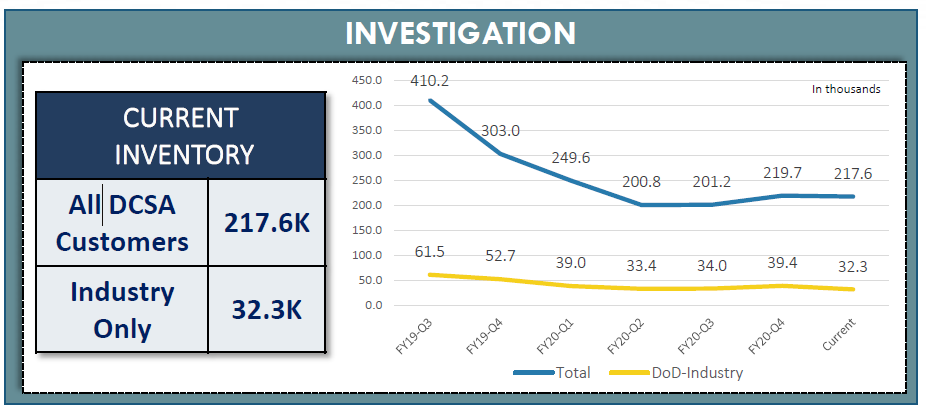DCSA juggling security clearance transformation, agency transition efforts
The Defense Counterintelligence and Security Agency is a little more than a year old, and it's still adding more mission areas. It recently acquired the legacy ...
Best listening experience is on Chrome, Firefox or Safari. Subscribe to Federal Drive’s daily audio interviews on Apple Podcasts or PodcastOne.
It’s been nearly a year since the National Background Investigations Bureau merged with the Defense Security Service to become the Defense Counterintelligence and Security Agency, and the federal government’s main security clearance provider.
DCSA has gotten bigger since, adding a few mission areas and more than 100 additional employees at the start of the new fiscal year, the agency’s director, Bill Lietzau, said earlier this week at a meeting of the National Industrial Security Program Policy Advisory Committee.
“During this period… it’s like we’re in charge of changing the engines in this airplane while it’s flying,” he said. “We have to keep our missions going. Our industrial security mission continues. Our personnel vetting mission continues. We have to continue flying the plane, but we have to change it from a turboprop to a jet while we’re flying it — and make sure we don’t lose altitude while it’s happening.”
The pandemic has forced DCSA to set aside some cases where the agency’s background investigators can’t access the records necessary to complete a security clearance, and the inventory is up slightly in recent months because of it.
According to DCSA data, there are 217,600 security clearances pending today, but the total is still within the agency’s “steady state” goal of 200,000-to-225,000 active investigations.

But beyond the regular security clearance work, DCSA is also reorganizing and adding more mission areas.
It recently acquired more than a dozen IT systems from other agencies and DoD entities, including the Office of Personnel Management’s legacy security clearance system, Lietzau said.
“The plan originally a year ago was that OPM would continue to run the legacy IT architecture,” he said. “Your taxes are paying about $150 million a year to keep that thing up and running. OPM recently told us they just weren’t staffed to be able to keep it running in spite of the original agreement, so DoD had to adopt it on Oct. 1.”
DCSA also brought the Defense Information Systems Agency program office that’s designing, building and testing a new personnel vetting IT system into the fold. That system, known as the National Background Investigation Services (NBIS), won’t be ready to replace the legacy IT architecture “in the immediate future,” Lietzau said.
“In some ways some of the advertised capabilities it was going to provide were based on technological development as opposed to an operationally-relevant capability,” he said. “In that regard, some of the promises and expectations were more sanguine than they should have been.”
Lietzau, who took over as DCSA director this past spring, said his office has developed a new baseline and more realistic requirements for the NBIS project, as well as a more thorough and coordinated master schedule.
The goal, Lietzau said, is to set a schedule for NBIS that allows the department to sunset the legacy system while building the new one. It will also factor in the Trusted Workforce 2.0 initiative, the large-scale modernization effort that’s supposed to overhaul the suitability, credentialing and security clearance enterprise.
The new requirements for NBIS now factor in the continuous evaluation and vetting program and some additional high-side capabilities that weren’t part of the original plan, Lietzau said.
“We’re putting it all together in a way that best protects our security,” Lietzau said. “We are in a timeline where we have completed most of the transfers. There’s a few more things that are happening a year from. We’re in transition, and then we’re in the thick of transformational efforts right now as an organization.”
Continuous evaluation enrollment levels off slightly
Continuous evaluation and vetting are key to those transformation efforts.
Roughly 2.3 million people are enrolled in DoD’s continuous evaluation program to date, including 455,000 industry clearance holders, according to DCSA.
DoD has added nearly 1 million more clearance holders to the continuous evaluation program within the last year, though the department estimated last November it would reach 3.6 million enrollees by the end of 2020.
Still, the agency anticipates a significant surge in continuous evaluation participation within the next 10 months.
“You will see enrollment increase significantly in this fiscal year as we work to achieve the goal of [having the entire] cleared population into Trusted Workforce compliance,” said Donna McLeod, executive program manager at DCSA.
The goal for CE enrollment isn’t surprising, considering the Trump administration’s embrace of continuous evaluation and continuous vetting. Both CE and CV are cornerstones to the administration’s Trusted Workforce 2.0 initiative.
As part of that initiative, OPM and the Office of the Director of National Intelligence are finalizing a federal personnel core vetting doctrine, a guidebook of sorts for agencies on the administration’s new policy goals.
The doctrine should be finalized soon once the security and suitability executive agents sign off on the document and publish it to the Federal Register, ODNI’s Kyla Power said.
ODNI is also developing another executive correspondence on Trusted Workforce 2.0, which will describe how agencies can adopt continuous vetting and perform automated records checks on their clearance holders, she added.
Copyright © 2024 Federal News Network. All rights reserved. This website is not intended for users located within the European Economic Area.
Nicole Ogrysko is a reporter for Federal News Network focusing on the federal workforce and federal pay and benefits.
Follow @nogryskoWFED
Related Stories





